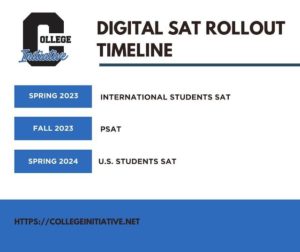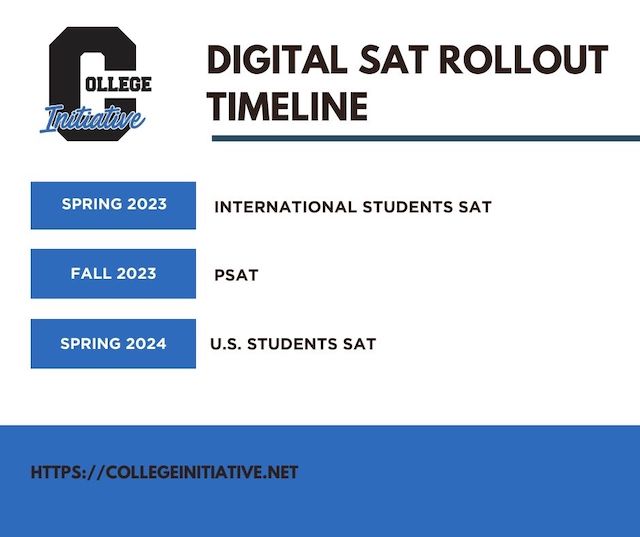The Digital SAT vs The Paper SAT – What You Need to Know
Last Updated on October 13, 2023 by Jill Schwitzgebel
It’s true – there’s a new college entrance exam in town – the digital SAT. The SAT is almost a rite of passage for college-bound high school students and has been given in roughly the same pencil and paper format since its inception in 1926. It actually evolved from an IQ screening test for Army recruits! Along the way, there have been some changes in length and format, and a major change when they moved to a Scantron-style answer sheet for easier scoring. But, the exam recently took another leap forward by going digital. Let’s talk about some of the differences between the new digital SAT vs the paper SAT.
 Why Make the Switch?
Why Make the Switch?

The College Board believes that the switch to a digital format will make the test more student-friendly and students agreed in the pilot study. They say the digital test is easier to take and easier to administer. Students say it feels less stressful to take and administrators no longer have to spend hours sorting and then shipping test materials. And, as an added bonus, the College Board says that it will also be more secure. That’s important as there have been some high profile cheating cases in recent years.
The switch to digital format is already complete outside of the US, as of spring 2023. And within the US, the SAT will be administered as fully digital by Spring 2024.
The Changes
1. Test Locations
There are actually no changes in locations. The SAT will still be given at testing centers or at schools. Students may not take it remotely.
2. Test Materials
It’s pretty obvious that the major difference is that students won’t be using pencil and paper to answer the questions. Instead, students will download an app called “Bluebook” to their own device, or to a device they borrow from their school. The device can be either a Mac or Windows enabled computer, a Chromebook, or an IPad (if it has a detached keyboard). For students using laptop computers, they must use the keyboard attached to the laptop, but may use a detached mouse. Whatever device students are using must be connected to Wifi.
Students will have the ability to highlight text, flag questions or use an embedded calculator. Students will still have the ability to go back and change answers within each module.
2. Registration
There is no change to the way in which students register to take the exam. However, the test should be more readily available, as the format changes allow for more flexibility with more testing windows to be opened up for students.
3. Timing
Here’s the news that makes many teens happy – it’s shorter! The current paper format is three hours long. The digital format is just over two hours long. The reasons for that are explained in the next section.
4. Content
There are four sections:
Section 1
- Reading and Writing Module 1 (27 questions, 32 minutes)
- Reading and Writing Module 2 (27 questions, 32 minutes
- (10 minute break)
Section 2
- Math Module 1 (22 questions, 35 minutes)
- Math Module 2 (22 questions, 35 minutes)
And here is where there is a major change: this test is adaptive. That means that a student’s performance on Module 1 in each section determines what questions they will be given for module 2. The second section has two formats – one with slightly easier questions overall, and one with slightly harder questions for students that performed at a higher level on module 1. Ultimately, this changes how scoring is done (see Scoring, below). The questions will trend slightly more difficult throughout each module on the test. Students will have slightly more time on average, to answer each question, than they have on the paper test.
Note that the first modules are labelled “Reading and Writing.” These are no longer separate like in the paper format. Students will get a mix within each module. Reading questions will be the first half of the R&W sections, followed by the writing questions. The reading analysis passages will now be much shorter, down to 25-150 words from 500-750 and each passage will have a single question, rather than multiple questions. And the writing questions will no longer have the option for “No Change” as an answer.
In the Math section, students will now be able to use the calculator on each section. They can use the one built-in to the app or their own approved outside device. Imaginary and complex numbers will no longer be on the exam and students will have access to a reference sheet with common formulas.
Finally, there is no longer an experimental section where the College Board tests questions. But now, there are two experimental questions embedded in the exam, which will not be scored. Students will not know which questions those are.
5. Scoring
The paper format test relies on the number of correct and incorrect answers for a score. With the digital, adaptive format, an algorithm assigns different weights to different questions, so getting a more difficult question right will mean more than getting an easier question correct. The only way to get a perfect score will be to do well enough on the first module of each section to be assigned the more difficult module two.
The scoring scale remains unchanged, with a possible 800 on each module.
6. Accommodations
All accommodations previously available, will still be available to students. The method that students use in order to request accommodations is also unchanged. Features like text-to-speech, screen readers, and adjustable font sizes should help make it even more accessible to many students.
7. Test Security
While there are still likely to be test proctors, theoretically, their jobs should be easier. This new digital version has introduced security measures to prevent cheating, like secure browser software and video monitoring of students.
8. Score Reporting
This is another big advantage of the digital SAT vs the paper SAT – faster score reporting! Students no longer have to wait two weeks to receive their scores.
Advantages and Challenges
In October 2023, counselors and students across the country encountered the first challenge of the new digital format. Thousands of students were unable to access the entirely digital PSAT on test day, causing it to have to be rescheduled. As I write this, there has not been much communication from the College Board about what happened, but presumably, their system was overwhelmed by the number of students logging in. Hopefully, that will have been rectified.
As all of us have experienced, technology does have glitches at times. There may be issues with connectivity during the exam or a student’s device may not be cooperative that day (but the College Board says that the test is set up so that if that happens, students will NOT lose their work to that point). But, there were issues in the past with the paper version as well – sometimes the exams mailed to the schools for test day, didn’t arrive. Or, leaked copies of paper exams sometimes caused the College Board to have to cancel the scores for all students at a certain test center.
So, yes, there are trade-offs, but there are also advantages to the new format. The College Board believes that the digital test platform will be more equitable for students and should increase accessibility of all kinds. As mentioned previously, the new format seems to provide more flexibility in scheduling the exams. The ability to receive scores more quickly should be an advantage to students, especially those taking the test close to college application deadlines. The new format means the questions are randomized, making it really difficult for students to share answers, reducing cheating. And, I certainly can’t discount the environmental benefits! The digital format significantly reduces paper waste.
Conclusion
Ultimately, the College Board is just keeping up with the times. Today’s students are quite comfortable with technology, and 80% of students that sampled the digital format agreed that this felt less stressful to them. Regardless of format, students are taking the exam for the same reason they always have – as a way to show that they are ready for college coursework. In a test-optional world, scores don’t have the same significance as in the past, but for some students, they are helpful.
If your student is planning to take the SAT in digital format, I highly recommend they become familiar with it by checking out https://satsuite.collegeboard.org/digital/digital-practice-preparation.











